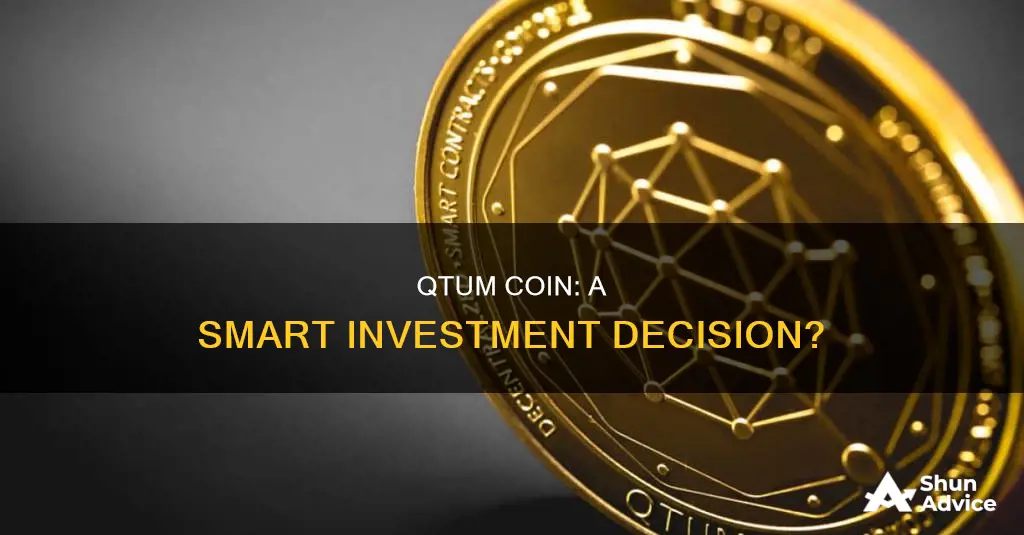
Qtum is a cryptocurrency that combines the security of Bitcoin's blockchain model with the flexibility of Ethereum's smart contracts. It was founded in 2016 by Patrick Dai, Jordan Earls, and Neil Mahl, and its initial coin offering (ICO) was held in March 2017. Qtum is a scalable, proof-of-stake platform that allows developers to leverage the benefits of both Ethereum and Bitcoin. It is designed for use by large organizations, with the goal of becoming integral to a range of industries, including finance and social media. Qtum is truly decentralized, with no delegated proof of stake or other forms of masternodes required for validation. It also has a unique ability to change parameters in a decentralized fashion, making its features very censorship-resistant. While Qtum has a lot of potential and support from powerhouse investors, it also faces fierce competition from other similar crypto projects and has a small community.
What You'll Learn

Qtum's scalability and energy efficiency
Qtum is a cryptocurrency that combines the security of Bitcoin's blockchain model with the flexibility of Ethereum's smart contracts. It uses a proof-of-stake consensus model for creating new blocks, which is far easier and less energy-intensive than Bitcoin's proof-of-work model.
Qtum is designed to be scalable and energy-efficient. Its proof-of-stake mechanism allows participants to use low-powered devices to stake, or even do it offline to save more energy. Qtum's layer 1 network currently supports around 1100 transactions per second (TPS), and it can theoretically achieve "millions to billions" of TPS by combining various layer-1 and layer-2 solutions.
The Qtum Blockchain also implements the Decentralized Governance Protocol (DGP), which enables quick adjustments to network parameters in response to scaling or security issues. For example, governing parties can vote to increase the block size from 2 MB to 4 MB, instantly changing the network rules without requiring software upgrades or downtime. With DGP, Qtum can handle 70 TPS on-chain, and the possibility is much higher with lightning networks and other off-chain payment networks (up to 20,000 TPS within 12-18 months).
In addition to scalability, Qtum also addresses the challenges of independence, privacy, and governance faced by Decentralized Application (DApp) platforms. Qtum's use of the "UTXO" Blockchain model and the Account Abstraction Layer (AAL) technology enables the interaction of the UTXO and smart contract models, providing a high level of transactional security.
The Ultimate Guide to Investing in Bitcoin
You may want to see also

Qtum's decentralisation
Qtum is a decentralised blockchain-powered network that combines the best features of Bitcoin and Ethereum. It uses Bitcoin's secure UTXO model and Ethereum's account-based model, on which developers can build applications. This creates an entirely new blockchain network that improves on the shortcomings of Bitcoin and Ethereum.
Qtum is more decentralised than most blockchains. It has a unique ability to change parameters in a decentralised fashion. The community has access to a set of smart contracts that can adjust the cost of gas, block size, and other important features.
Qtum uses a proof-of-stake consensus model for creating new blocks, which is far easier and less energy-intensive than Bitcoin's proof-of-work model. Qtum is designed for use by large organisations, with the goal of becoming integral to a range of industries, including finance and social media.
Qtum is the only blockchain that manages to merge Bitcoin and Ethereum's legacy architecture, ensuring Bitcoin-level security and Ethereum-level flexibility. It is a scalable, Proof-of-Stake platform that allows developers to leverage the upstream benefits of Ethereum and Bitcoin.
Qtum uses a decentralised governance protocol that allows token holders to vote for representatives. This avoids endless debates and updates that are indefinitely postponed.
Qtum is promoted as a decentralised platform and indicates the number of nodes in each country. At the time of writing, there are 6,271 nodes. The four countries with the most nodes are China, South Korea, the United States, and Japan.
Qtum is also working on two major partnerships: with Starbucks and 360 Finance, a Chinese financial technology company. These partnerships could give Qtum more access to Chinese markets and help it compete with other platforms.
Britannia Coins: A Smart Investment Move?
You may want to see also

Qtum's blockchain and its use of Bitcoin's UTXO model
Qtum is a blockchain network founded in 2016 that combines the security of Bitcoin's blockchain model with the flexibility of Ethereum's smart contracts. Qtum uses the unspent transaction output (UTXO) model, a sort of accounting system used by Bitcoin that provides a high level of transactional security.
The UXTO system provides a type of receipt for unspent coins after a transaction. For example, if Alice has 25 Bitcoins and uses 1 Bitcoin to buy a laptop from Bob, the transaction creates two outputs: one for 1 Bitcoin to Bob and another for the remaining 24 Bitcoins back to Alice. These outputs are indivisible, meaning they are either spent in their entirety or not at all. Once validated and added to a new block, this transaction becomes a permanent part of the blockchain.
The UTXO model enables traceability and accountability by allowing each transaction output to be traced back to its originating transaction. This makes it possible to audit the entire history of a particular set of coins, which is crucial for regulatory compliance and forensic accounting.
Qtum copied and reworked Bitcoin's UTXO code for its own platform. One of the key differences between Qtum and Bitcoin is that Qtum uses a proof-of-stake consensus model for creating new blocks, which is far easier and less energy-intensive than Bitcoin's proof-of-work model. Qtum also employs a decentralized governance protocol, allowing for blockchain parameters like block size, block time, gas schedules, and minimum gas price for contracts to be modified without ecosystem disruption.
The combination of Ethereum's smart contract functionality and Bitcoin's UTXO model, along with its decentralized nature and proof-of-stake consensus mechanism, makes Qtum a unique and attractive option for developers and users.
Best Bitcoin Stocks: Where to Invest Your Money
You may want to see also

Qtum's smart contracts
Qtum is a cryptocurrency that combines the security of Bitcoin's blockchain model with the flexibility of Ethereum's smart contracts. It is a scalable, proof-of-stake platform that allows developers to leverage the benefits of both Bitcoin and Ethereum. Qtum is more decentralised than most blockchains, meaning that the features offered on the platform are very censorship-resistant.
The community has access to a set of smart contracts that can adjust the cost of gas, block size, and other important features. Qtum uses the Ethereum Virtual Machine for smart contract operations. It also has a unique ability to change parameters in a decentralised fashion.
Qtum is designed for use by large organisations, with the goal of becoming integral to a range of industries, including finance and social media. It is a business-facing platform, allowing users to develop smart contracts and decentralised applications on a huge scale.
Smart contracts are guidelines for transactions. They are self-executing code that, once verified on the blockchain, carry out the terms of the deal, making the contract irrevocable.
Strategies Post-Bitcoin Investment: Steps to Take Now
You may want to see also

Qtum's price predictions
As of January 2023, Qtum was worth $3.50. In the same month, crypto experts predicted that the price of Qtum would be $3.82 by the end of 2023.
In May 2024, crypto experts predicted that the price of Qtum would be $1.63 by the end of the year. In September 2024, another source predicted that the price of Qtum would be $1.28 in the next 90 days.
In terms of long-term predictions, one source predicts that Qtum will be worth $4.28 by 2025, and $0 by 2026. Another source predicts that Qtum will be worth $20.29 by 2030, while a third source predicts a price of $21.59 by 2030.
It is important to note that cryptocurrency prices are extremely volatile and subject to rapid change. As such, these predictions should be taken with a grain of salt.
Swift Coin: Worthy Investment or Risky Business?
You may want to see also
Frequently asked questions
Qtum is a decentralised blockchain network that supports smart contracts using the Ethereum Virtual Machine. It is a hybrid of Ethereum and Bitcoin, using the latter's blockchain and the former's Virtual Machine. Qtum is designed to be used by large organisations, with the goal of becoming integral to a range of industries, including finance and social media.
Qtum is a general-purpose blockchain that aims to address four issues in BTC and ETH blockchain platforms: interoperability, governance, rigidity, and the costliness of the proof-of-work mechanism, as well as the difficulty of connecting smart contracts with real-life applications. Qtum has two unique technologies that aim to solve these issues: the Account Abstraction Layer (AAL) and the Decentralized Governance Protocol (DGP).
As of August 2024, the live Qtum price is $2.31 USD with a 24-hour trading volume of $26,658,688 USD. The current CoinMarketCap ranking is #177, with a live market cap of $242,834,538 USD.
While Qtum has a lot of potential and is backed by powerhouse investors, it also has strong competitors in the form of Ethereum and NEO. Qtum also faces competition from other similar crypto projects and does not stand out with its technology and innovation. It is not considered a good long-term hold by some experts. However, others predict a positive outlook for Qtum, with one source stating that Qtum is "not a money-making scheme. Think of [it] as the technology of the future."







